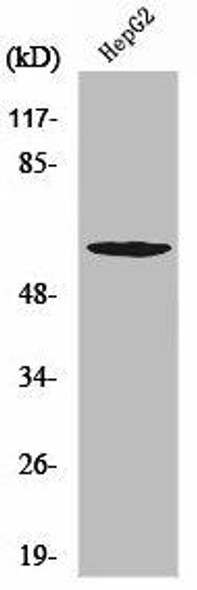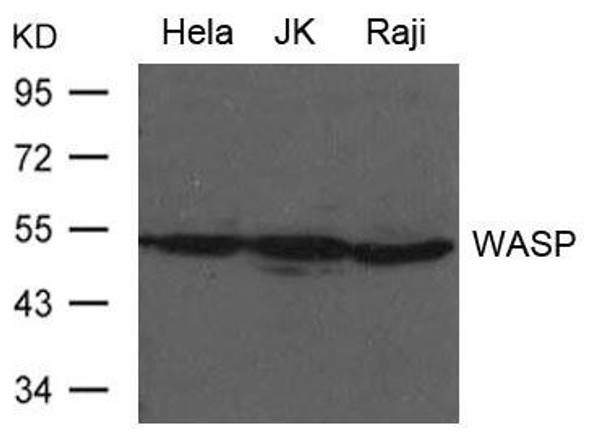KCNMA1 Antibody (PACO35358)
- SKU:
- PACO35358
- Product type:
- Antibody
- Reactivity:
- Human
- Host Species:
- Rabbit
- Isotype:
- IgG
- Application:
- ELISA
- Application:
- IHC
- Application:
- IF
- Antibody type:
- Polyclonal
- Conjugation:
- Unconjugated
Description
| Antibody Name: | KCNMA1 Antibody (PACO35358) |
| Antibody SKU: | PACO35358 |
| Size: | 50ug |
| Host Species: | Rabbit |
| Tested Applications: | ELISA, IHC, IF |
| Recommended Dilutions: | ELISA:1:2000-1:10000, IHC:1:20-1:200, IF:1:50-1:200 |
| Species Reactivity: | Human |
| Immunogen: | Recombinant Human Calcium-activated potassium channel subunit alpha-1 protein (1-86AA) |
| Form: | Liquid |
| Storage Buffer: | Preservative: 0.03% Proclin 300 Constituents: 50% Glycerol, 0.01M PBS, PH 7.4 |
| Purification Method: | >95%, Protein G purified |
| Clonality: | Polyclonal |
| Isotype: | IgG |
| Conjugate: | Non-conjugated |
 | Immunohistochemistry of paraffin-embedded human brain tissue using PACO35358 at dilution of 1:100. |
 | Immunofluorescent analysis of Hela cells using PACO35358 at dilution of 1:100 and Alexa Fluor 488-congugated AffiniPure Goat Anti-Rabbit IgG(H+L). |
 | Immunohistochemistry of paraffin-embedded human pancreatic tissue using PACO35358 at dilution of 1:100. |
| Background: | Potassium channel activated by both membrane depolarization or increase in cytosolic Ca(2+) that mediates export of K(+). It is also activated by the concentration of cytosolic Mg(2+). Its activation dampens the excitatory events that elevate the cytosolic Ca(2+) concentration and/or depolarize the cell membrane. It therefore contributes to repolarization of the membrane potential. Plays a key role in controlling excitability in a number of systems, such as regulation of the contraction of smooth muscle, the tuning of hair cells in the cochlea, regulation of transmitter release, and innate immunity. In smooth muscles, its activation by high level of Ca(2+), caused by ryanodine receptors in the sarcoplasmic reticulum, regulates the membrane potential. In cochlea cells, its number and kinetic properties partly determine the characteristic frequency of each hair cell and thereby helps to establish a tonotopic map. Kinetics of KCNMA1 channels are determined by alternative splicing, phosphorylation status and its combination with modulating β subunits. Highly sensitive to both iberiotoxin (IbTx) and charybdotoxin (CTX). |
| Synonyms: | Calcium-activated potassium channel subunit alpha-1 (BK channel) (BKCA alpha) (Calcium-activated potassium channel, subfamily M subunit alpha-1) (K(VCA)alpha) (KCa1.1) (Maxi K channel) (MaxiK) (Slo-alpha) (Slo1) (Slowpoke homolog) (Slo homolog) (hSlo), KCNMA1, KCNMA SLO |
| UniProt Protein Function: | KCNMA1: Potassium channel activated by both membrane depolarization or increase in cytosolic Ca(2+) that mediates export of K(+). It is also activated by the concentration of cytosolic Mg(2+). Its activation dampens the excitatory events that elevate the cytosolic Ca(2+) concentration and/or depolarize the cell membrane. It therefore contributes to repolarization of the membrane potential. Plays a key role in controlling excitability in a number of systems, such as regulation of the contraction of smooth muscle, the tuning of hair cells in the cochlea, regulation of transmitter release, and innate immunity. In smooth muscles, its activation by high level of Ca(2+), caused by ryanodine receptors in the sarcoplasmic reticulum, regulates the membrane potential. In cochlea cells, its number and kinetic properties partly determine the characteristic frequency of each hair cell and thereby helps to establish a tonotopic map. Kinetics of KCNMA1 channels are determined by alternative splicing, phosphorylation status and its combination with modulating beta subunits. Highly sensitive to both iberiotoxin (IbTx) and charybdotoxin (CTX). Defects in KCNMA1 are the cause of generalized epilepsy and paroxysmal dyskinesia (GEPD). Epilepsy is one of the most common and debilitating neurological disorders. Paroxysmal dyskinesias are neurological disorders characterized by sudden, unpredictable, disabling attacks of involuntary movement often requiring life-long treatment. The coexistence of epilepsy and paroxysmal dyskinesia in the same individual or family is an increasingly recognized phenomenon. Patients manifest absence seizures, generalized tonic-clonic seizures, paroxysmal nonkinesigenic dyskinesia, involuntary dystonic or choreiform movements. Onset is usually in childhood and patients may have seizures only, dyskinesia only, or both. Belongs to the potassium channel family. Calcium- activated (TC 1.A.1.3) subfamily. KCa1.1/KCNMA1 sub-subfamily. 7 isoforms of the human protein are produced by alternative splicing. |
| UniProt Protein Details: | Protein type:Endoplasmic reticulum; Channel, potassium; Membrane protein, integral; Membrane protein, multi-pass Chromosomal Location of Human Ortholog: 10q22.3 Cellular Component: voltage-gated potassium channel complex; apical plasma membrane; plasma membrane; integral to membrane; caveola Molecular Function:protein binding; calcium-activated potassium channel activity; voltage-gated potassium channel activity; large conductance calcium-activated potassium channel activity; metal ion binding; actin binding Biological Process: synaptic transmission; regulation of membrane potential; positive regulation of apoptosis; smooth muscle contraction involved in micturition; response to hypoxia; blood coagulation; response to calcium ion; response to osmotic stress; cellular potassium ion homeostasis; negative regulation of cell volume; potassium ion transport; micturition Disease: Generalized Epilepsy And Paroxysmal Dyskinesia |
| NCBI Summary: | MaxiK channels are large conductance, voltage and calcium-sensitive potassium channels which are fundamental to the control of smooth muscle tone and neuronal excitability. MaxiK channels can be formed by 2 subunits: the pore-forming alpha subunit, which is the product of this gene, and the modulatory beta subunit. Intracellular calcium regulates the physical association between the alpha and beta subunits. Alternatively spliced transcript variants encoding different isoforms have been identified. [provided by RefSeq, Jul 2008] |
| UniProt Code: | Q12791 |
| NCBI GenInfo Identifier: | 46396283 |
| NCBI Gene ID: | 3778 |
| NCBI Accession: | Q12791.2 |
| UniProt Secondary Accession: | Q12791,Q12886, Q12917, Q12921, Q12960, Q13150, Q5JQ23 Q5SQR9, Q96LG8, Q9UBB0, Q9UCX0, F8WA96, |
| UniProt Related Accession: | Q12791 |
| Molecular Weight: | 138,297 Da |
| NCBI Full Name: | Calcium-activated potassium channel subunit alpha-1 |
| NCBI Synonym Full Names: | potassium large conductance calcium-activated channel, subfamily M, alpha member 1 |
| NCBI Official Symbol: | KCNMA1 |
| NCBI Official Synonym Symbols: | SLO; BKTM; SLO1; MaxiK; SAKCA; mSLO1; KCa1.1; SLO-ALPHA; bA205K10.1 |
| NCBI Protein Information: | calcium-activated potassium channel subunit alpha-1; uncharacterized protein; hSlo; k(VCA)alpha; slo homolog; slowpoke homolog; BKCA alpha subunit; maxi-K channel HSLO; BK channel alpha subunit; stretch-activated Kca channel; calcium-activated potassium channel, subfamily M subunit alpha-1 |
| UniProt Protein Name: | Calcium-activated potassium channel subunit alpha-1 |
| UniProt Synonym Protein Names: | BK channel; BKCA alpha; Calcium-activated potassium channel, subfamily M subunit alpha-1; K(VCA)alpha; KCa1.1; Maxi K channel; MaxiK; Slo-alpha; Slo1; Slowpoke homolog; Slo homolog; hSlo |
| Protein Family: | Calcium-activated potassium channel |
| UniProt Gene Name: | KCNMA1 |
| UniProt Entry Name: | KCMA1_HUMAN |










